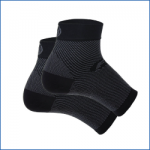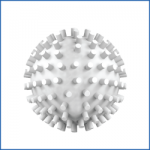Did you know that your golf swing can strain the muscles in your feet, legs, abdomen and back? Playing the game on a hilly terrain doesn’t help either, as it increases these forces, leading to a higher probability of injury. If biomechanical issues exist, these stresses will overload structures, predisposing you to overuse muscles and strain ligaments and tendons. Therefore, completing a proper warm-up with stretching exercises specific to golf can help injury prevention.
Other problems, such as tendonitis, capsulitis, and ligament sprains and pulls, can also keep a golf enthusiast back at the clubhouse. Improper shoes can also present issues as they cause blisters, neuromas (inflamed nerve endings) and other pains in the feet.
Injuries caused directly or indirectly by foot function?
Research indicates that recreational golfers tend to sustain more injuries than professional golfers.
The risk of injury also increases as you get older. Generally, overuse injuries tend to occur because the joint and tendon tissues become less able to withstand stress as we age.
Common conditions

Plantar fasciitis
Plantar fasciitis is the number one cause of heel pain. It’s frequently linked with a history that includes a sudden increase in activity, new footwear, transitioning from indoor to outdoor training or recent weight gain.
Plantar fasciitis pain is concentrated on the bottom centre of the heel, where the plantar fascia inserts onto the heel bone. The plantar fascia is a strong band of connective tissue attached to the bottom of the heel bone and extends to the toes. It acts as a truss or support for the arch and foot.
When the heel moves or rotates too much, or your arch is higher or low, there is increased stress on the plantar fascia, leading to microtearing off the bone. This microtearing causes inflammation and pain. Pain is typically worse when first getting up in the morning or after a period of rest.

The Orthosleeve FS6 helps ease and reduce swelling with 6 zones of compression to increase circulation and reduce inflammation.

Massage balls can be effective in breaking up scar tissue that may have formed due to inflammation.
Knee problems
Inflammation or pain in the knees is caused by the twisting motion of the golf swing and sometimes by walking in ill-fitting shoes. Rest, re-evaluating your swing and foot orthotics can help prevent knee injuries.
Shin splints
Pain in your lower leg muscles is commonly caused by excessive walking after a period of inactivity. It can also be due to over-pronation in the feet, putting excessive pressure on the lower leg.
Hallux limitus
Hallux Limitus is a condition in which the movement of the big toe becomes restricted, limiting the range of motion.
A prominence or bump can occur on the top of the big toe joint, restricting the range of motion and resulting in a ‘jamming’ of the joint. Jamming or deterioration of the big toe joint cartilage is caused by overextension during the follow-through. The joint swells, stiffen and limits its motion. Hallux Limitus can be so painful that it affects your walking and eventually hampers your swing.
Achilles tendonitis
These injuries occur when the tendon that connects the shin to the heel becomes inflamed or begins to degenerate. This condition is caused by wearing improper footwear, inflexible calf muscles and neglecting to stretch before a golf match. It is important, therefore, to wear adequately cushioned shoes with firm arch support, replacing worn-out shoes and stretching and strengthening your calf muscles.
Metatarsalgia
Metatarsalgia is a common cause of pain in the ball of the foot. This pain is characterized by a deep, dull or throbbing pain that occurs while sitting and standing. When you walk, the pain can be sharp.
Metatarsalgia causes swelling and inflammation near the joint of your second toe. People with a second toe that is longer than the big toe develop this condition at a higher rate than others.
Morton’s neuroma
Morton’s Neuroma is a painful condition that leads to foot and toe numbness or burning. It is caused when the tissues surrounding the nerve thicken or the nerve linked to the toes swells. People with Morton’s neuroma describe a sensation like standing on a pebble. Golfers commonly experience this condition, particularly if they walk a lot or wear tight golf shoes with little room for the toes to flex.





